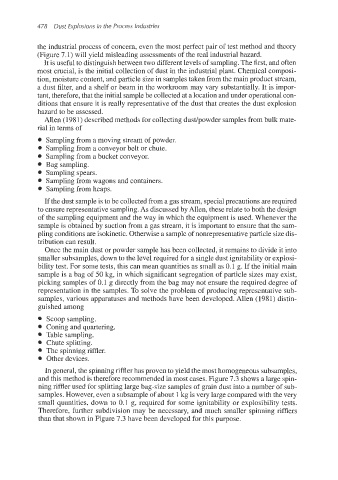Page 511 - Dust Explosions in the Process Industries
P. 511
478 Dust Explosions in the Process Industries
the industrial process of concern, even the most perfect pair of test method and theory
(Figure 7.1) will yield misleading assessments of the real industrial hazard.
It is useful to distinguishbetween two differentlevels of sampling. The first, and often
most crucial, is the initial collection of dust in the industrial plant. Chemical composi-
tion, moisture content, and particle size in samplestaken from the main product stream,
a dust filter, and a shelf or beam in the workroom may vary substantially.It is impor-
tant, therefore, that the initial sample be collected at a location and under operational con-
ditions that ensure it is really representative of the dust that creates the dust explosion
hazard to be assessed.
Allen (1981) described methods for collecting dust/powder samples from bulk mate-
rial in terms of
Sampling from a moving stream of powder.
Sampling from a conveyor belt or chute.
Sampling from a bucket conveyor.
Bag sampling.
Sampling spears.
Sampling from wagons and containers.
Sampling from heaps.
If the dust sample is to be collectedfrom a gas stream, specialprecautions are required
to ensure representative sampling.As discussedby Allen, these relate to both the design
of the sampling equipment and the way in which the equipment is used. Whenever the
sample is obtained by suction from a gas stream, it is important to ensure that the sam-
pling conditions are isokinetic.Otherwise a sample of nonrepresentativeparticle size dis-
tribution can result.
Once the main dust or powder sample has been collected, it remains to divide it into
smaller subsamples, down to the level required for a single dust ignitability or explosi-
bility test. For some tests, this can mean quantities as small as 0.1 g. If the initial main
sample is a bag of 50 kg, in which significant segregation of particle sizes may exist,
picking samples of 0.1 g directly from the bag may not ensure the required degree of
representation in the samples. To solve the problem of producing representative sub-
samples, various apparatuses and methods have been developed. Allen (1981) distin-
guished among
Scoop sampling.
Coning and quartering.
Table sampling.
Chute splitting.
The spinning riffler.
Other devices.
In general, the spinningriffler has proven to yield the most homogeneous subsamples,
and this method is therefore recommendedin most cases. Figure 7.3 shows a large spin-
ning riffler used for splitting large bag-size samples of grain dust into a number of sub-
samples. However, even a subsampleof about 1kg is very large compared with the very
small quantities, down to 0.1 g, required for some ignitability or explosibility tests.
Therefore, further subdivision may be necessary, and much smaller spinning rifflers
than that shown in Figure 7.3 have been developed for this purpose.

